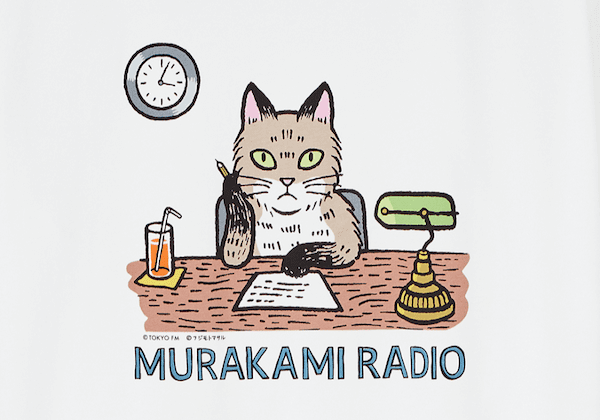It wasn’t until this year that I discovered Haruki Murakami’s luminous literary oeuvre. In March, I read Norwegian Wood and fell in love with its rendering of late 1960’s and ‘70’s Japan – its jazzy soundscapes, textural characters and dynamic urban and natural environments, swimming between Tokyo, Kyoto and the mountains.
When I completed the novel, UNIQLO happened to release a new clothing collection – ‘Murakami Radio’. I was surprised for two reasons. The first was enmeshed with an appreciation of serendipity – that UNIQLO had released a literary-themed clothing line about Murakami, parallel to my introduction to him. The second was more profound, built upon the surprise that a clothing brand, one that I’d encountered and knew, had created a collection with a literary theme at all.
The collection infuses Murakami’s notorious jazzy bravado and intellectual quirkiness into a series of shirts paying homage to each of his central novels. UNIQLO’s interpretation of Norwegian Wood – a simple, forest green shirt with scarlet writing emblazoning the novel’s title across its chest – stood out to me for its stark simplicity. Compared to the other shirts in the collection, like the anthropomorphic, jazzy feline headlining a Murakami Radio shirt, and Kafka on the Shore’s intricate Japanese calligraphy winged along a stencil of a nightingale, UNIQLO’s interpretation of Norwegian Wood reminded me of the seamlessness of the relationship between fashion and literature.
This seamlessness has been echoed elsewhere in 2021. In February, Maison Valentino established their ‘Writer’s Campaign.’ With contributors including Ocean Vuong, Elif Shafak, and Donna Tart, Valentino’s 2021 Fall/Winter Collection has allowed these authors to create literary vignettes capturing particular pieces from the Collection. Each vignette intimately engages with one’s emotional response to and relationship with fashion. Vuong’s piece chases Leonardo Da Vinci and Gian Giacomo Caprotti, his apprentice, across ‘streets lit with dawn’s bluest seconds’, built along carefully enjambed lines leading to the sea, ‘her black dress a stitch in the shore’. Tart captures a woman waiting for a date, ‘all Valentino-ed up’, and Shafak uses the blank space of the page to cross-stitch protest, literature and fashion into a kind of ‘Valentino Red’ textual bodice.
My initial surprise at UNIQLO’s ‘Murakami Radio’ Collection, which doubled upon encountering Valentino’s ‘Writer’s Campaign’, reflects something interesting. Prior to my encounter with these two campaigns, I had not seriously reflected, as a lover of literature, on its influence upon fashion. In an age where social media dominates the generation of new clothing and fashion trends, UNIQLO and Valentino are reviving literature as a focal point of inspiration in the fashion sphere. Although we thought that the pervasiveness of the Instagram hashtag and the boistrousness of TikTok had eclipsed the influence of literature on fashion, maybe it is time to reconsider what is truly in vogue.
Seminal authors like Oscar Wilde and Virginia Woolf emphasised the centrality of fashion to understanding their own work. In his The Philosophy of Dress, Wilde argued that fashion, and the representation of it within literature and other art forms, allows for a deeper engagement with art itself. His famous adage from this essay; “Fashion is ephemeral. Art is eternal’, solidifies the continuous and intertwined relationship that both had, and continue to have, on each other.
Think of the opening line that Woolf had originally given to her novel Mrs Dalloway: “Mrs Dalloway said she would buy the gloves herself.” Even though the novel in its published form did not use this line as its opening, it gestures towards the significance of fashion, of appearances, as markers of historical progression and how people understand themselves.
Woolf in Orlando also observes that ‘there is much to support the view that it is clothes that wear us and not we them. We may make them take the mould of arm or breast, but they mould our hearts, our brains, our tongues to their liking.’ Literature’s self-reflectivity and reflexivity is best understood through its relationship with fashion. Although the magnetic pull of alternative influences appear to stand as more ‘contemporary’ and ‘relevant’, literature can rest on the arguably perpetual, yet dynamic, relationship it has with fashion, and by extension, with how we understand ourselves and the world.
Midori, one love interest of Norwegian Wood’s protagonist Watanabe, is deliberately named so. ‘Midori’ means green in Japanese: a colour central to the novel’s diaphanous, spectral colour palette. When they initially meet, Midori can’t help but notice the ‘Humphrey Bogart’ sophistication of his green polo. She notes that “green looks terrible on me… I’m cursed”. Later in the novel, after a sustained period of silence blooming out of certain events distorting Watanabe’s relationship Midori, he spots her in a lecture theatre, ‘wearing a deep green pullover and the dark sunglasses she had often warn all summer.’
It is in fashion, that signifier, that conduit facilitating the evolution of our relationships and self-understanding, that literature finds a seemingly unlikely companion. Murakami, like so many authors, constructs moments where his characters struggle with this dynamic. But, by the novel’s end, Murakami re-positions his characters and audience in the mirror of fashion’s relationship with literature, enabling them to achieve self-apotheosis and comfort in who they are, and how they interact with others.
If, in the words of Coco Chanel, where ‘fashion changes, style endures’, we can be sure of at least one thing — that literature will continue to breathe life and weave inspiration into fashion.





